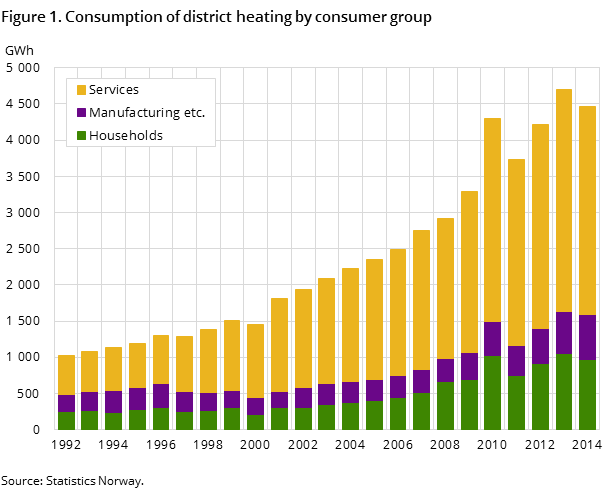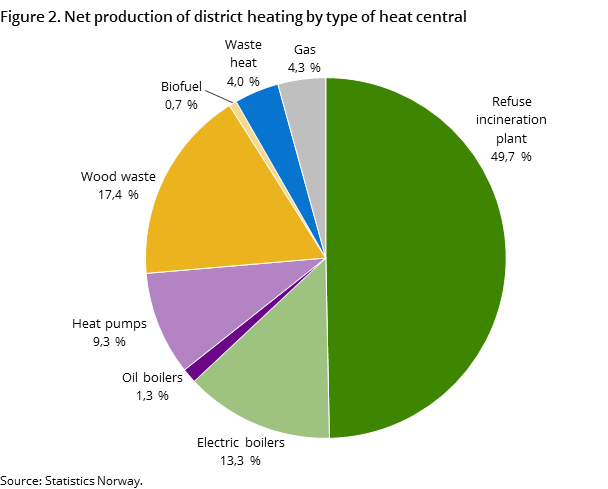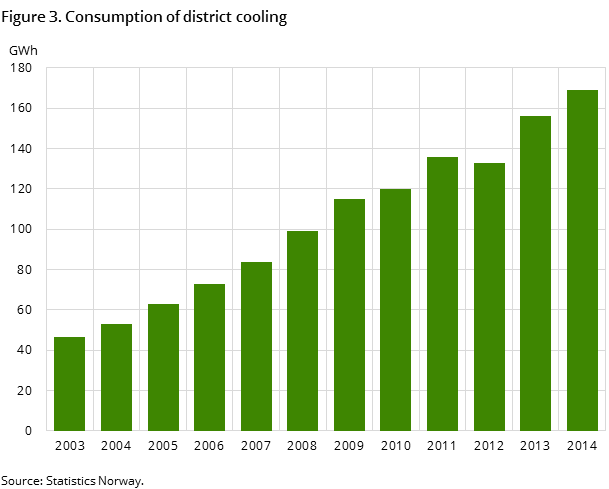Content
Published:
This is an archived release.
Reduced consumption of district heating
District heating consumption decreased by 5.1 per cent in 2014 compared to the year before and amounted to 4.5 TWh. Consumption of district cooling came to 169 GWh in 2014; an increase of 8.3 per cent from 2013.
| 2014 | Share in per cent | Per cent change compared to last year | |
|---|---|---|---|
| District heating delivered to cunsumer (GWh) | 4 462 | 100.0 | -5.1 |
| ¬ Households | 967 | 21.7 | -8.3 |
| ¬ Manufacturing etc. | 616 | 13.8 | 6.0 |
| ¬ Services | 2 879 | 64.5 | -6.1 |
| Average price district heating (taxes excluded) (øre/kWh) | 58.5 | -1.2 | |
| Total investments (1 000 NOK) | 1 466 617 | 7.4 |



Lower consumption of district heating and higher consumption of district cooling can be seen in conjunction with the record high average temperature in 2014. The average temperature in 2014 was 2.2 degrees above normal, while in 2013 it was 1.0 degree above normal.
65 per cent of district heating consumption in service industries
Service industries continued to account for the largest share of consumption in 2014, and their use of district heating accounted for about 2.9 TWh. Twenty-two per cent of the total district heating consumption, or about 1 TWh, was delivered to households, while consumption in industry accounted for 13 per cent, or 616 GWh.
Waste most common in the production of district heating
Waste incineration is the main energy source for district heating. In 2014, about 50 per cent of district heating, or 2.5 TWh was produced from waste. The second largest source of energy was waste wood facilities, with a share of around 17 per cent, which amounted to 873 GWh in 2014. The shares of district heating produced from electrical, gas and oil boilers as well as bio fuel and heat pumps decreased somewhat compared with 2013, while the share of waste heat remained unchanged.
Lower price
The average price for district heating decreased from 59.2 øre/kWh in 2013 to 58.5 øre/kWh in 2014. For households and the service sector, the average price was 59.6 and 61.1 øre/kWh respectively, while it was lower for industry – 33.7 øre/kWh. The price for cooling amounted to 85.4 øre/kWh in 2014; 3.9 øre/kWh lower than 2013.
Reduced district heating consumption and low price contributed to reduced sales revenues from district heating in 2014. The revenues from district heating decreased by 5.8 per cent compared to 2013 and amounted to NOK 2.5 billion. The revenues from district cooling were NOK 144 million; 3.4 per cent higher compared to the year before.
Higher investments
Total investments in district heating plants increased by 7.4 per cent and equalled around NOK 1.5 billion in 2014. Of this amount, NOK 945 million was invested in production plants and NOK 402 million in distribution facilities. Other investments amounted to about NOK 120 million.
District cooling included in the statisticsOpen and readClose
Since 2013, the time series on consumption, sales incomes and average price of district cooling have been included in the statistics publication.
Contact
-
Ann Christin Bøeng
E-mail: ann.christin.boeng@ssb.no
tel.: (+47) 40 81 13 58
